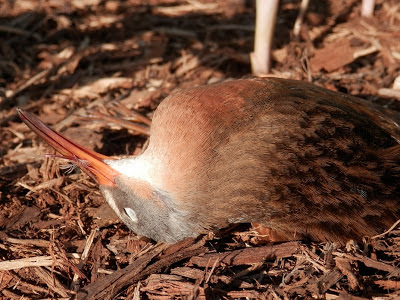A dead Summer Tanager at the Omaha-Douglas Civic Center is the 100th species found in association with known window-bird strikes in eastern Omaha. The carcass of a first year male, despite being found soggy and forlorn on the west side of the building, at the south end in a corner of the plaza, was nonetheless colorful with subtle hues of red and yellow, with features of its plumage instantly indicative. Based upon its degraded condition, the fatality probably occurred May 27th, though it was not found until the 28th. The former bit of wildbird life was placed into my personal bird-carrier bag, hung on the bicycle frame, and later disposed of at a natural place, rather than getting tossed, indifferently into some container full of human's trash.
 |
The first hours of Monday morning were too rainy, based upon rain drops on the roof and radar perspective, for the usual survey as done along a regular route, via numerous and nearly continuous rotations of bicycle pedals; excluding the downhill parts of the route. This is the second recent morning where a survey was not done, due to the current rainy and stormy cycle of weather.
Also found Tuesday morning were a couple of Least Flycatchers at the CenturyLink Center Omaha (one soggy dead carcass and one disabled bird moved to a safer space). A soggy Tennessee Warbler and female Baltimore Oriole, both lingering carcasses, were at the west side of the Omaha Public Power District Energy Plaza, a few feet south of the buildings' west entrance. The latter two were probably also from the 27th.
This morning's outing was not very smooth because of an especially obvious defect of my transportation. A side of the rear wheel rim of the bicycle split, so when the tire had correct pressure, a metallic bulge meant the brake pad hit the brake pad, causing the wheel to jump and then jerk when using the rear brake. Nothing was smooth and it was also noisy, and a complete bother. Add to this, that when walking, the tire would often stop revolving when it got stuck at the four-inch long bulge, which only stuck out about a quarter of an inch which was however enough to cause the wheel to not turn and drag along the surface, whether it was sidewalk, grass or mud on this Tuesday. The whole situation was a negative diversion, resulting in many words better left ignored for the day!
The situation was profoundly obvious in a negative manner, just a short time later, while going about Carter Lake and Levi Carter Park on another morning bird survey, because winds were finally light in the early a.m. Despite the vexing mechanics, it was nice to prominently see a live Scarlet Tanager along the southeast shoreline of the lake, its red-and-black plumage obvious, among the arboreal realm. This was a new addition to the species recorded among the spaces at this place.
Later, back at the house after an unknown multitude of pedals on a muggy morning where blue skies eventually replaced the clouds, and after removing the wheel, removing the tire and tube, some prying efforts were tried with a tool. The attempt to force the metal back into proper alignment was unsuccessful, though it did seem that the rim lines were suitably aligned. Once the tire, under pressure and back in place on the bicycle frame, and the wheel was turned to determine it if was suitable for riding, it became obvious real soon that there was no improvement. The only result was dirty fingers, that had to be scrubbed clean at the kitchen sink.
It's time, again, for the well-worn Giant — that would be the model type — to get taken to the Walnut Hill bicycle shop for installation of a new rim. This had been planned to get done in a few days, because of at least five broken spokes, but the newly found break has moved forward the day to get the ride repaired. Now more than 25 years old, the frame and handlebars of this essential and omnipresent feature of so-many city travels is likely the only remaining original parts.
There will be many more rides upon its two wheels (which still needs new handle grips, a front tire, and a seat). Perhaps, maybe, in the future there might will be a new cycle, one of them with the big wheels, fewer gears, a really comfortable seat and smooth in all of its operations, and most importantly, without the need for repairs!
While walking back from delivering the bicycle, a small plastic bag of recyclable cans and plastic was picked from along the dirty Omaha Streets. Another was also filled to overflowing on the walk back — along a different route — to pick up the bicycle once the repair was completed.

Plastic trash removed from Omaha streets so it could be recycled.















































